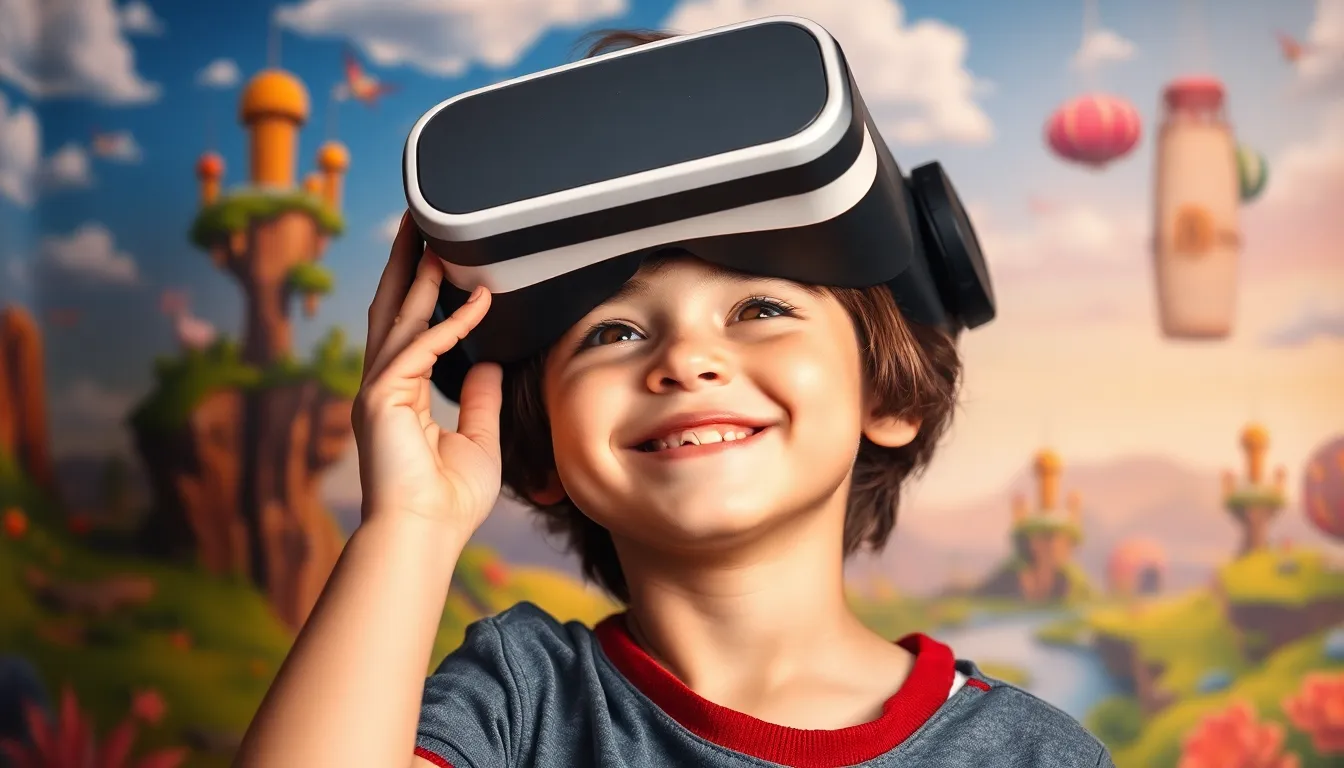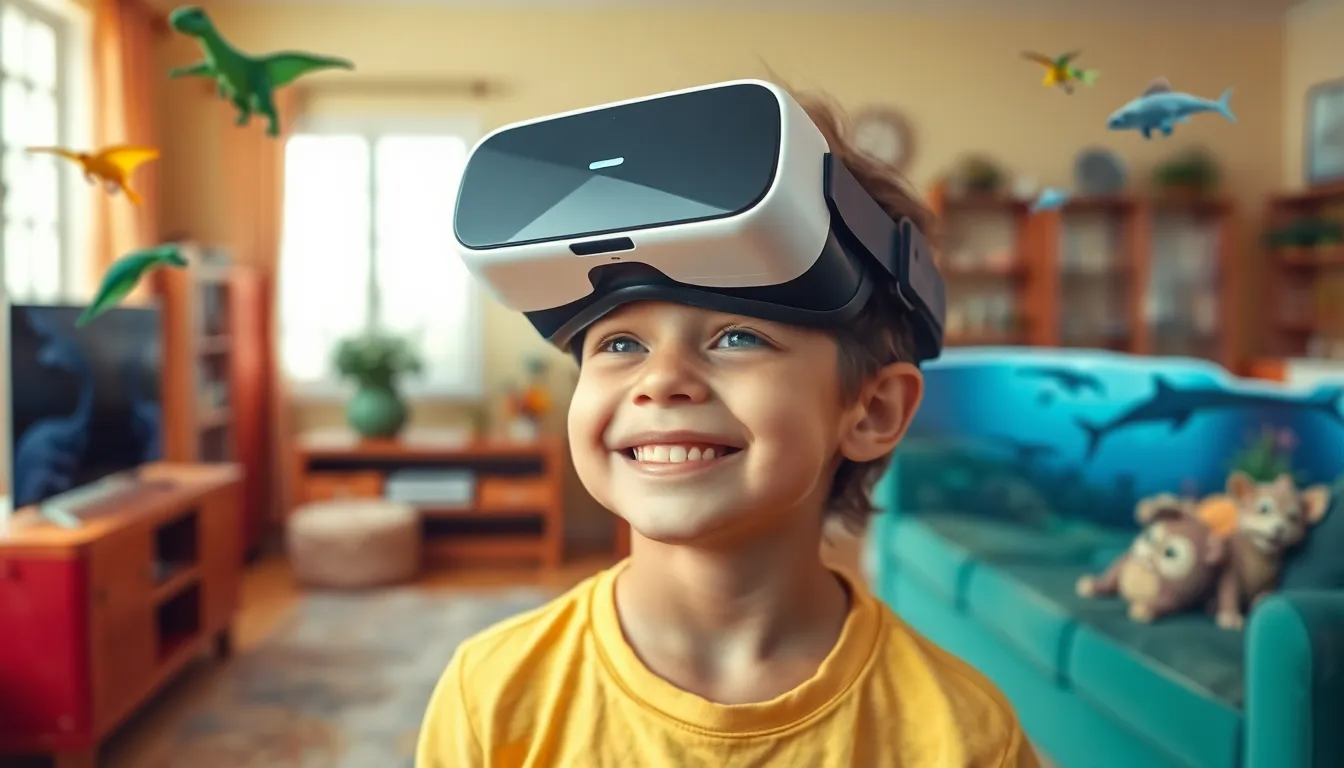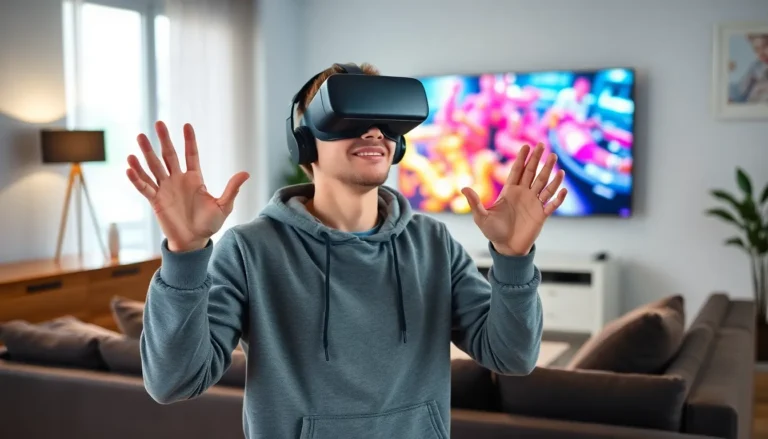Imagine a world where kids can explore the depths of the ocean, soar through the skies, or even meet dinosaurs—all from the comfort of their living room. Virtual reality (VR) is making this dream a reality, transforming playtime into an adventure of epic proportions. But wait, before you picture your child as a couch potato with a headset, let’s dive into how VR can actually boost creativity, learning, and social skills.
Table of Contents
ToggleOverview Of VR For Kids
Virtual reality (VR) offers unique opportunities for children. Engaging with immersive environments encourages exploration and creativity.
What Is VR?
VR creates simulated environments that users can interact with using a headset. These environments can simulate real-world locations or fantastical settings. Children experience these simulations through visual and auditory elements, providing a sense of presence. Many VR applications feature games and educational content designed specifically for kids. Interactive experiences make learning enjoyable and boost retention.
Importance Of VR In Child Development
VR plays a significant role in child development by promoting cognitive skills. It enhances problem-solving abilities as children navigate challenges in virtual worlds. Social interactions occur in multiplayer environments, allowing kids to collaborate and communicate. Learning through VR can aid in understanding complex subjects, such as science and history. Additionally, immersive experiences foster empathy by enabling kids to see life from different perspectives.
Benefits Of VR For Kids

Virtual reality (VR) offers significant advantages for children’s development. Engaging with immersive environments fosters various skills crucial for their growth.
Enhancing Learning Experiences
VR transforms traditional learning methods by creating interactive simulations of complex subjects. Children grasp abstract concepts more effectively when they can visualize and manipulate them. Experiencing historical events or scientific phenomena in VR deepens understanding and retention. Additionally, this technology supports various learning styles, catering to visual, auditory, and kinesthetic learners. Enhanced engagement through gamified lessons motivates students to explore topics actively. VR also promotes collaboration during group activities, allowing kids to work together on projects and problem-solving tasks.
Encouraging Creativity and Imagination
Children unleash their creativity within immersive VR environments. They can construct virtual worlds, design characters, or create artistic masterpieces without physical constraints. Such experiences spark innovative thinking and allow self-expression in unique ways. Exploring new narratives and scenarios stimulates imaginative play, essential for cognitive development. Furthermore, VR encourages interactive storytelling, enabling kids to become active participants in the tales they explore. Engaging with diverse content broadens their horizons and inspires fresh ideas. Kids develop the confidence to experiment creatively, nurturing their artistic potential.
Risks And Concerns
Virtual reality (VR) technology poses several risks and concerns for children. Understanding these potential issues is crucial for parents and caregivers.
Physical Health Risks
Extended VR use can lead to discomfort and physical issues. Eye strain is common when children view screens for too long. Experiencing motion sickness due to mismatched visual and sensory inputs also occurs frequently. Additionally, accidents may happen as kids engross themselves in virtual environments, losing awareness of their surroundings. Proper break intervals are essential to mitigate these physical risks. Monitoring session lengths can help maintain a healthy balance.
Psychological Implications
The immersive nature of VR can affect children’s emotional well-being. Overexposure to virtual content might blur the lines between reality and fantasy, leading to confusion. Some children may develop heightened anxiety or fear related to experiences in virtual settings. Social isolation can happen when kids prioritize VR over real-life interactions. Open discussions about their experiences in VR can help alleviate misunderstandings and maintain emotional health. Regularly assessing usage and providing guidance fosters a healthier relationship with technology.
Popular VR Platforms For Kids
Several VR platforms cater specifically to children, offering a variety of headsets and educational applications that enhance their learning experiences.
Recommended VR Headsets
Oculus Quest 2 stands out as a top choice for kids. Its standalone capability eliminates the need for a PC, making it user-friendly. PlayStation VR provides immersive gaming experiences, suitable for older kids due to its broader content library. Meanwhile, Pico G2 4K offers an affordable option without compromising quality. LeapFrog’s educational headset engages younger children with interactive learning tailored to their developmental needs. Each headset presents unique features that appeal to various age groups and interests, ensuring children find the right fit for their VR adventures.
Engaging Educational Apps
Numerous educational apps harness VR’s potential, capturing children’s imaginations. Google Expeditions lets kids explore settings like the Great Wall of China or the depths of the ocean, expanding their knowledge. NASA’s Space Explorers app immerses children in the solar system, sparking curiosity about space and science. Keep Talking and Nobody Explodes promotes teamwork and communication skills, encouraging collaborative problem-solving in a fun way. Tilt Brush introduces kids to artistic expression, enabling them to create 3D artwork in a virtual space. These applications enhance learning by making complex subjects accessible and enjoyable.
Virtual reality offers a remarkable opportunity for children to engage in creative and educational experiences that can shape their development. By immersing themselves in interactive environments, kids can enhance their cognitive skills and explore complex subjects in a fun way.
While it’s essential to monitor usage and address potential risks, the benefits of VR in fostering creativity and social interaction are undeniable. With a variety of platforms and apps tailored for young learners, parents can find suitable options that align with their child’s interests and learning styles.
Embracing VR as a tool for growth can lead to a more enriched learning experience, allowing children to explore new worlds while developing essential skills for the future.




